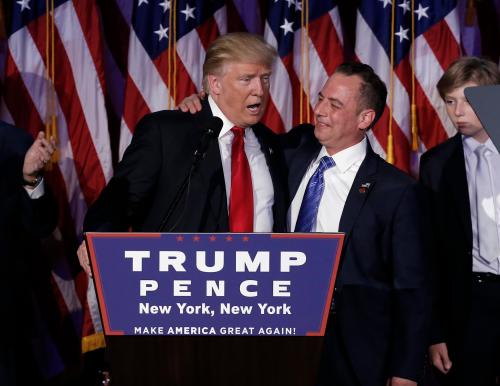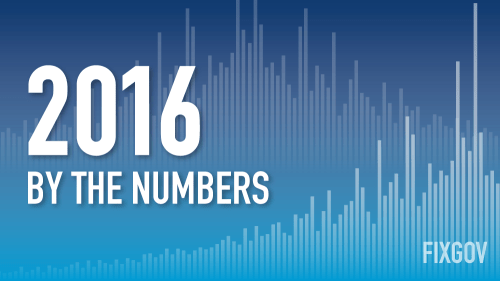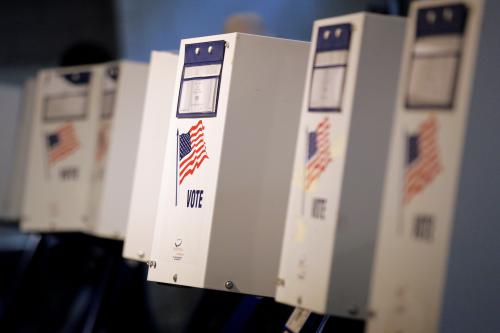Much of the analysis about the 2016 election has focused on Democrats’ failure to connect with a particular group of economically-marginalized voters: white working-class Americans. The analysis of Democratic performance in this context offers some accurate observations, while failing to provide a comprehensive assessment of the role of one’s economic status in voting behavior.
Defining “white working-class”
There have been countless news stories analyzing the role of the white working class in this election, but what do analysts, politicians, and the media mean by this term? Some use whites without a college degree as a basis. Others focus on income levels, like people earning less than $50,000 per year. By the first measure, Trump trounced Clinton. According to exit polls, white voters without a college degree composed 34 percent of the electorate and Trump won 67 percent to Clinton’s 28 percent among them. If you assume about 130 million voters turned out last Tuesday, that amounts to about 29.6 million voters from this group casting ballots for Trump, as opposed to just 12.4 million for Clinton.
| Table 1 – National Exit Polls, Income, 2012 and 2016 | |||
|
2012 |
Obama | Romney | |
| Under $50k (41%) | 54% | 44% | |
| Over $50k (59%) | 44% | 54% | |
|
2016 |
Clinton | Trump | |
| Under $50k (36%) | 52% | 41% | |
| Over $50k (64%) | 47% | 49% | |
| Source: CNN National Exit Polls 2012, 2016 | |||
We don’t have accurate exit poll data on the intersection of race and income—that is a metric showing whites earning less than $50,000 per year to assess the latter metric, but some insight can be drawn. Clinton beat Trump 52 percent to 41 percent among voters earning less than $50,000 annually—of which a notable number will be non-white. By comparison in 2012, exit polls suggested President Obama bested Mitt Romney 60 percent to 38 percent among these voters, suggesting significant falloff in the Democratic share among this population. Given that Trump’s and Romney’s numbers among non-whites were generally similar, a significant part of the falloff between 2012 (Obama) and 2016 (Clinton) was due to more whites shifting away from the Democratic ticket (toward Trump and more so a third party).
At the same time however, the idea that Trump activated the white working class is harder to justify. Yes, he won more votes. But the idea of a wave—Trump-motivated turnout—is challenged by the data. In 2012, voters without a college degree made up 53 percent of the electorate, while in 2016, that number had fallen to 50 percent. Voters earning under $50,000 a year made up 41 percent of the electorate in 2012, but only 34 percent of the electorate in 2016. Some may argue that falloff in those demographics could be due to decreases in non-white turnout, while masking increases in voting among whites in those groups. However, overall, the composition of the electorate by race held stable between 2012 and 2016.
So there are two takeaways from these data: Trump absolutely decimated Clinton among white working class voters, but there is no evidence to support the claim that he motivated more of those voters to the polls.
…the idea that Trump activated the white working class is harder to justify.
The white working class doesn’t own economic marginalization
There are many groups in this country who are economically marginalized. Structural changes in the economy, growing inequality, and an uneven economic recovery in the wake of the Great Recession have each caused hardship for many. People suffer from low wages, higher levels of unemployment, higher uninsured rates and despite the gains in the economy over the past seven years, these Americans still struggle to get ahead. The conversation around the “economically marginalized” has focused almost exclusively on white working class voters, and that is a travesty. There are many other Americans who are not traditionally grouped under the heading “white working class voters” who remain economically marginalized—and most of them voted for someone other than Donald Trump.
Four groups in this country who face some of the most significant economic marginalization are young people (I define as the 18-24 demographic), women, African Americans and Latinos. Yes, young people and women surely compose the white working class. But the archetype often used to represent this group is the out-of-work, white male factory worker from the Midwest or similar such imagery. My colleagues across Brookings have written for years about such marginalization and the extension of the groups who fall into that critical economic demographic. Richard Reeves, Belle Sawhill, Ron Haskins and others have written tirelessly about how these groups have been hit hardest by the recession, how they have struggled most during the recovery, and how economic mobility is out of reach for many.
Some data allow us to put the economic marginalization of these groups into perspective. A glance at the latest unemployment numbers shows this struggle. In October 2016, overall unemployment sat at 4.9 percent, while unemployment for white Americans edged down to 4.3 percent. Last month, however, black unemployment stood at 8.6 percent and unemployment among Latinos was 5.7 percent.
Unemployment statistics are dramatically worse for younger Americans. In Q3 2016, 15.6 percent of Americans 18-19 were unemployed as were 8.4 percent of those 20-24. Figure 1 highlights how significantly higher those numbers are for young people of color versus both the national average and the rate for whites.

With regard to unemployment numbers, women fare quite well versus men—a statistic that is generally true across racial and ethnic groups. Yet, compensation tells another story. When examining median weekly earnings, women earn less than men, people of color earn less than whites, and the intersection—women of color—face the most significant wage disparities in our nation. Figure 2 shows differences in median wages by ethnicity in Q3 2016. The numbers are alarming. Latinos earn 69 cents for every dollar a white American earns, while African Americans earn 80 cents on the dollar.

Figure 3 takes a dive into differences in earnings for both gender and race. Overall, women earn less than 82 cents for every dollar a male earns and those disparities grow larger for women of color. For example, Latinas earn less than 64 cents for every dollar a white male makes. That type of economic marginalization is real and many Americans feel it in their paychecks every week.

Another way, beyond pay and employment, that many Americans feel marginalized involves access to healthcare. Regardless of who you blame for outcomes that leave Americans uninsured, millions of Americans in this country remain without access to healthcare coverage. Once again, those numbers show significant differences by age and race. In June 2016, the uninsured rate in the U.S. stood at 8.9 percent overall. For Americans 18-24, that number stood at 14.1 percent, despite provisions in the Affordable Care Act that allows individuals 26 and under to remain on their parents’ insurance. Among Americans 18-64, the uninsured rate nationally was 12.4 percent. That figure was only 8.7 percent for white Americans. Communities of color saw a much different scenario. Black Americans were uninsured at a rate of 14.8 percent, while Latinos were uninsured at twice the national average—24.8 percent!
How the economically marginalized voted
It is clear from these statistics, the analyses by my colleagues, and dozens of other metrics that young Americans, women, and communities of color are economically marginalized. Many people from these demographic groups make up the very middle class that pundits and analysts say were ignored and voiced their anger at the ballot box on November 8th. The idea that this election was about the economically marginalized elevating Mr. Trump to the presidency seems to make sense for white voters. Yet, white voters cannot claim ownership of the economic marginalization label.
This post opened discussing the gains Mr. Trump made among marginalized whites. Those gains are both real and impressive. But it is important to discuss how other marginalized groups voted in this election. Voters age 18-24 made up 10 percent of the electorate this year—a one percentage point decrease from four years ago. Hillary Clinton beat Donald Trump 56 percent to 35 percent among these voters. While Clinton’s support was down from Obama’s 60 percent four years ago, Trump was not even able to muster the support Romney had among this demographic. A full 65 percent of Americans aged 18-24 voted for someone other than the Republican standard bearer.
A similar story is true for women. In 2016, women composed 52 percent of the electorate (a one-point decrease from 2012). Fifty-four percent of women cast ballots for Hillary Clinton, compared to 42 percent for Trump. Compared to 2012, Clinton’s support among women dropped by one percent, while Trump’s dropped two percent from Romney’s support. Like with younger voters, women supported Clinton by significant numbers and the falloff from Obama to Clinton benefited third party candidates and not the GOP nominee.
Black Americans and Latinos are among the more economically marginalized groups in the U.S. and both groups voted overwhelmingly against Donald Trump. Black voters composed 12 percent of the electorate, giving Clinton 88 percent of their support—meaning nearly 14 million black voters opted to back the Democratic nominee. To his credit, Trump increased the GOP share of the black vote to eight percent from Romney’s six percent in 2012.
| Table 2 – National Exit Polls, Race, 2012 and 2016 | |||
|
2012 |
Obama | Romney | |
| White (72%) | 39% | 59% | |
| Black (13%) | 93% | 6% | |
| Latino (10%) | 71% | 27% | |
|
2016 |
Clinton | Trump | |
| White (70%) | 37% | 58% | |
| Black (12%) | 88% | 8% | |
| Latino (11%) | 65% | 29% | |
| Source: CNN Exit Polls, Race, 2012 and 2016 | |||
Similarly, Latinos—11 percent of the electorate—supported Clinton with 65 percent of the vote to Trump’s 29 percent. The six-point falloff from Obama’s 2012 performance among Latinos generally aided third party candidates, although Trump bested Romney’s numbers by two points. Overall a full 92 percent of black voters and 71 percent of Latinos (an approximately combined 24.5 million Americans of color) chose someone different than the president-elect.
The conversation around the middle class, the economically marginalized, and the overlooked Americans needs a larger dose of honesty than it has had in the past week. There are many demographic groups and sub-groups in the United States who are struggling economically. They are not all white. They are not all located in the upper Midwest. They are not all displaced, male factory workers or coal miners. They are not all middle aged. The economically marginalized in this country are, sadly, a diverse group of people from all racial and ethnic backgrounds, genders, ages, and occupations.
Donald Trump, fairly, won the electoral college because he offered a campaign message that connected with one segment of those Americans who are struggling economically. He did not own the issues of economic justice or inequality or marginalization. For tens of millions of other voters who find themselves struggling in this economy, they went to the ballot box and opted for someone other than the president-elect, as did a majority of American voters.
Democrats have plenty of work to do rebuild the successful electoral coalition that worked for them in 2008 and 2012. Spending more time connecting with white working class voters will surely be on the party’s to-do list. However, the party did quite well among many economically marginalized American voters and pearl-clutching, end-of-days analyses about a party lost in the political wilderness has driven many to ignore that reality.







Commentary
A reality check on 2016’s economically marginalized
November 16, 2016